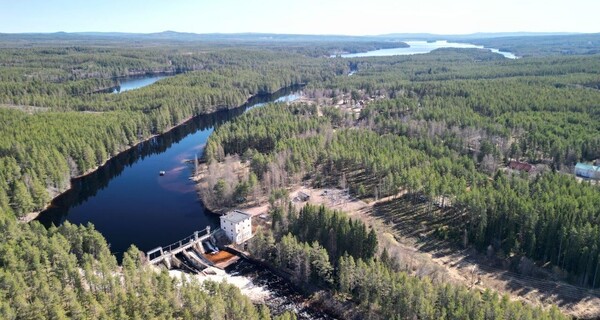Quick changes impact the environment
Short-term regulation of hydropower plants is used to produce electricity based on supply and demand and ensures grid stability, especially today when the amount of intermittent power sources like wind and solar increase. However, due to the quick changes in the water flow from the hydropower plant, negative environmental impacts may occur. Frequent, sudden and rapid flow changes due to hydropower operations are called hydropeaking. Depending on the local conditions, the environmental impacts may include stranding and drifting of fish and invertebrates, loss of spawning areas and reduction of suitable habitat, which overall leads to decreased biodiversity. In many rivers, authorities request natural hydrological regime, which would limit short-term regulation significantly.
Consequently, Fortum is dedicated to finding solutions to limit the impact and to expanding research in this area. Especially now, when the amount of flexible sources in the Nordic energy system rather should be increased.
The first Nordic study on constructional measures
In 2024, Johannes Eltzsch conducted a study for his master’s thesis at the Royal Institute of Technology (KTH), that investigated constructional mitigation measures to reduce the negative environmental impacts of hydropeaking. A theoretical case study was done, utilizing one of Fortum’s hydropower plants in River Oreälven as its focal point.
Firstly, an overview of three categories of mitigation measures was conducted, including operational (i.e. reduced peak flow), constructional (i.e. retention basins) and morphological (i.e. habitat improvements). Among the constructional mitigation measures, a retention basin was the most promising solution for the specific circumstances, prompting further investigation.
A retention basin, which is typically situated downstream of a hydropower plant, serves as a damping reservoir for water flow during hydropeaking, facilitating the release of a more consistent discharge into the river. This reduces the quick changes of water flow, thereby reducing ramping rates and improving the conditions for invertebrates and fish. In 2016, KWO Oberhasli AG in Switzerland completed the first retention basin for the targeted reduction of hydropeaking, a measure not yet adopted in the Nordics.
Source: Bruder et al., 2016. “A conceptual framework for hydropeaking mitigation”
Benefits increase with larger basin volumes
In the case study, the hydrological impacts of hydropeaking were measured by changes in the water level and the benefits through the implementation were calculated for different scenarios. Furthermore, the research demonstrated the mitigation measures’ suitability for use in Sweden and Finland.
Environmental impacts vary based on location and various factors. There is no universal solution, and effectiveness depends on specific circumstances. Not all impacts occur in every river or at every location in a river. When using a retention basin to mitigate environmental impacts, some preconditions are required. The location must have available space, ideally without the need for too much soil excavation. The power plant should be rather large, to be able to carry the high cost of the measure to be implemented. Additionally, the species and habitats requiring protection should be downstream in the river.
To test the effect and costs of retention basins, three different sizes, 20 000, 50 000 and 100 000 m3 were investigated in the study. Hydrological calculations showed that all three retention basins may reduce ramping rates, but benefits increase with larger basin volumes. However, one drawback of this mitigation measure is the high construction costs, which also increase with the size of the basin. The results are based on the selected hydropower plant and may differ for other plants.
The largest retention basin managed to limit the water level change to 15 cm per hour in this specific case. This corresponds largely with the recommended guidelines from literature of the topic.
Combined mitigation measures can lead to greater effects
The thesis concluded that combining different mitigation measures, operational, constructional and morphological, may lead to the best results concerning ecological benefits and cost-effectiveness.
Operational measures could be applied to decrease the necessary volumes of retention basins. Morphological measures can additionally be applied to increase and create habitat. In the future, their combined potential, spin-offs and trade-offs should be investigated further, to see how these different mitigation measures can work together.
For further research, more detailed cost calculations of implementing ramping restrictions and construction of retention basins are necessary, along with an evaluation of the environmental impacts within the river, both before and after mitigation measures. The environmental impacts on fish, invertebrates or riparian vegetation were not assessed in this study.
Short-term regulation is needed to meet supply and demand
The electricity market is facing great challenges, such as the expected increased power demand due to electrification and introduction of more intermittent power sources. Hydropower can help to secure power supply and grid stability. As a low-carbon electricity source, it fulfills requirements to combat climate change.
Short-term regulation is needed to meet supply and demand, secure power production, and avoid frequency imbalances. However, the environmental impacts resulting from the short-term regulation of hydropower plants make it crucial for Fortum to continue investigating mitigation measure possibilities.
For decarbonization investments to thrive in the Nordics, the industry must have confidence that, alongside base power, the fluctuations in intermittent electricity can be effectively balanced within our energy system. This ensures a continuous power supply for companies' electrified operations at all times.
